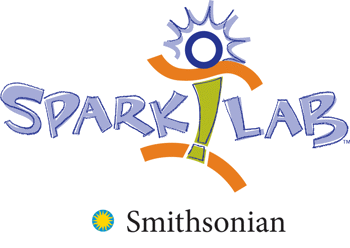Spark!Lab

 Spark!Lab
Spark!Lab
Spark!Lab is a hands-on creative lab that uses engaging activities to help kids and families learn about the history and process of invention. Attached to the Discovery Center, the Spark!Lab welcomes visitors to tinker, invent, conduct science experiments, and explore inventors' notebooks. Spark!Lab encourages children to explore their inventive creativity - to create, innovate, collaborate and problem-solve - because these experiences empower kids to develop the skills and confidence they need to succeed today and in the future.
Visitors spark critical thinking skills through games, conduct science experiments, explore inventors' notebooks, and invent. Activities include making a hydroponic garden, testing electric circuits, creating a flying gyroscope, and more.
The Anchorage Museum is home to one of only a few Spark!Labs outside the Smithsonian in Washington, DC.
Upcoming programs include, an evening series called SparkNite, and a look at the innovation, inventions and adaptations related to Alaska’s history and the Arctic environment.
Developed by the Lemelson Center for the Study of Invention and Innovation at the Smithsonian Institution National Museum of American History, Spark!Lab at the Anchorage Museum is made possible through the support of the Ford Motor Company Fund and First National Bank Alaska.
Spark!Lab Winter Hours (Oct. 1–April 30)
Tuesday through Friday
10 a.m. to 2 p.m. – Spark!Lab open to scheduled school groups only and closed to the public
2 p.m. to 5 p.m. – Spark!Lab open to general public
Saturday
10 a.m. to 2 p.m. and 3 p.m. to 5 p.m. – Spark!Lab open to general public
Sunday
Noon to 2 p.m. and 3 p.m. to 5 p.m. - Spark!Lab open to general public
Spark!Lab Summer Hours (May 1-Sept. 30)
10 a.m. to 2 p.m. and 3 to 5 p.m. daily
Generously Sponsored By:


Anchorage Museum Spark!Lab Activity Choices
- Gyroscopes: Since Jean Bernard Leon Foucault’s invention of the gyroscope in 1852, inventors have continually found new applications for these spinning marvels. Today, gyroscopes are used in aircraft, submarines, and rockets, as well as toys and smart phones. Visitors experiment with a variety of gyroscopes to learn more about how they work and have the chance to experiment making their own flying gyroscopes!
- Snap Circuits: Snap circuits include real circuit components just like the ones found inside radios, televisions, computers, and other electronic devices such as LEDs, light bulbs, fan motors, and even a musical doorbell.
- Soundscapes: Visitors use the parts and pieces in this activity to create music and sound pathways for marbles. They explore different configurations and try marbles of different sizes and materials to figure out which make the sounds they are looking for.
- Recycled Percussion Sculpture: Drums and percussion instruments are universal. Some of these instruments are familiar, such as drums, while other instruments are no so easy to recognize. What the instruments are made from, how they are played, and the sounds they make are all up to the inventor to decide. Visitors get inspired to invent their own musical instruments by playing the Recycled Percussion Sculpture, a collage of repurposed materials (drums, cymbals, and chimes) arranged in a free-standing wooden structure that sits on the floor. One inventor’s junk is another inventor’s masterpiece.
- Hydroponic Gardens: Believe it or not, some plants can grow without soil. This type of gardening is called hydroponics. Hydro is the Greek word for “water” and ponics means “work.” In hydroponic gardening, a solution of water and nutrients does the work for the soil. Visitors create their own hydroponic garden to take home.
- Art Inventions: Inventors and artists both create new things. As they create, they look for new and different ways to use tools and materials. Visitors use the supplies provided to create a work of art- a picture, a sculpture or something else.
- Now What?: In this interactive game, visitors use their problem-solving skills and (senses of humor) to answer the question, “Now what?” Players are given a problem and then specific materials to use to solve that problem. Thinking creatively to find an answer to the question “now what?” allows visitors to experience the kind of playful and flexible thinking that inventors, designers, and other creative people use all the time.
- Shaping Shoes: In this activity, visitors examine a wide range of shoes to learn how each is designed for a specific purpose: hiking, climbing, running, walking in the rain. A card attached to each describes how each shoe is innovative, and how that innovation helps to solve a particular problem. Visitors are then encouraged to invent their own shoe using materials provided.
- Mobile Masterpieces: Artists take properties from science and incorporate them into their work. The mobile is a great example of science merging with art. With the use of scales and balance, the mobile takes on great beauty. This activity allows visitors to explore the principles of balance and scale, and create their own mobiles.
- Spark!Lab Jr.: Even at a very young age, children can begin to develop the inventive thinking and problem solving skills. This kit provides a range of activities that encourage kids younger than five to play in inventive ways. These activities were developed from research conducted by the Lemelson Center for its Invention at Play exhibition and in consultation with the Smithsonian Early Enrichment Center. Activity includes a set of wooden blocks; a large, kid-friendly magnet, magnifying glass, and tape measure; a magnet exploration board; and a balance scale. Challenge Cards prompt kids to use the tools and materials to build, create, and explore the world around them